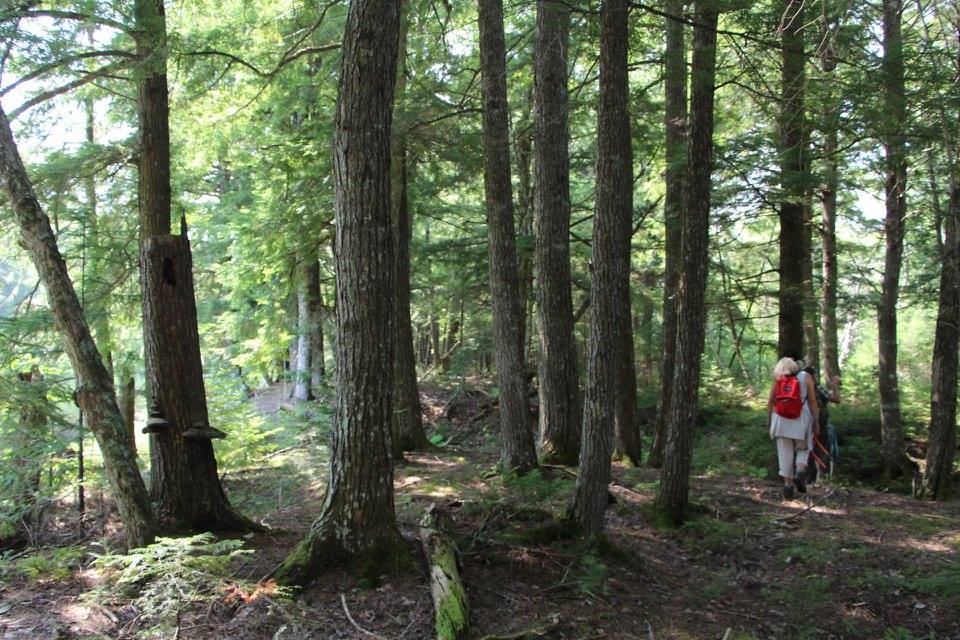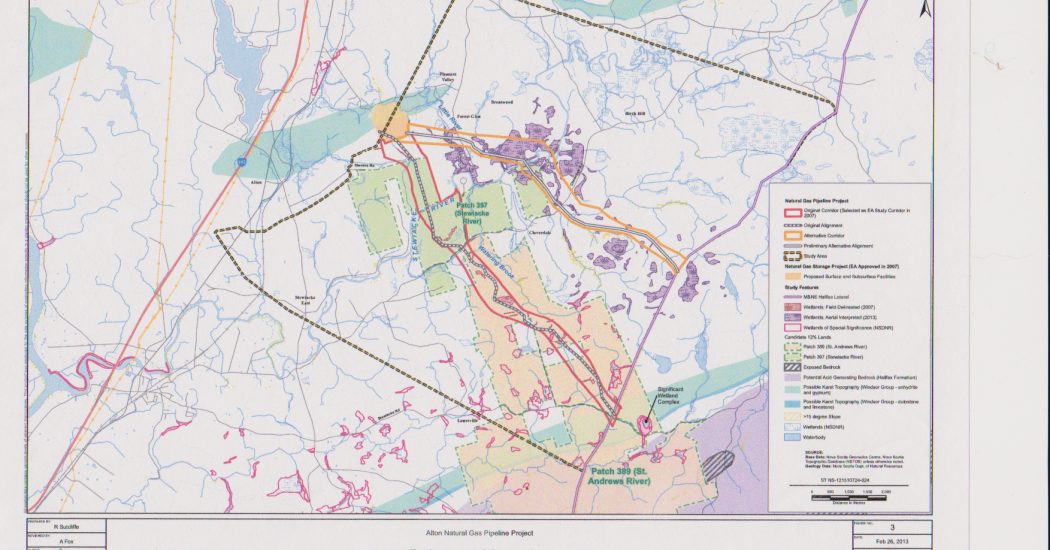KJIPUKTUK (Halifax) – Most Nova Scotians have heard about the Alton Gas Storage project by now. But even people who closely follow the ongoing struggle to stop Alton Gas may not be aware of the gas pipeline connecting the project to the Maritimes & Northeast Gas Pipeline network.
This proposed gas pipeline for the Alton Gas storage project is set to cross the Stewiacke River Wilderness Area, although naturalists are strongly opposed. As well, the proposed Saint Andrews River Wilderness Area boundaries were modified at the time, presumably to accommodate the pipeline.
The separate Nova Scotia Environment approval process for this proposed Alton Gas Pipeline is a story of how the Calgary company systematically and successfully wears down requirements for years, despite persistent objections from the Protected Lands division of the Environment Department.
In early 2010, AltaGas acquired the stalled Alton Gas project by purchasing and absorbing its developer, Landis Energy. Landis had received approval for all the other aspects of the project in 2007- while indicating its preferred route for the gas pipeline. Even though the gas pipeline environmental assessment was to be separate, the company had conducted some of the required species identification field work on the route.
At the same time that AltaGas purchased the stalled Alton Gas project, the provincial government purchased a large tract of land from Northern Pulp for the purpose of creating new protected areas. Most of the proposed gas pipeline passed through the heart of what was now slated to be turned into two protected areas, the Stewiacke River and St. Andrews River Wilderness Areas.
George Taylor has a cabin on the Stewiacke River, just outside the boundaries of the proposed Stewiacke River Wilderness Area. As an outdoor environmental educator for the City of Halifax Taylor brought hundreds of children and youths to appreciate the grandeur of the old growth forest that stretches up the river from his cabin. “I made formal submissions about the value of this protected area and have spoken to the Minister of Environment,” said Taylor. Alton Gas claims to have contacted landowners and nearby residents. George Taylor is the closest to the proposed pipeline right of way, but he was never approached.
While always referred to publicly as Alton Gas, the development of the project is entirely planned and executed by AltaGas executives and senior management in Calgary. Alton Gas has never had sustained local management. AltaGas set about in 2011 completing engineering and planning for the construction of the salt cavern and Shubenacadie River brining discharge facilities that received Environment Department approvals in 2007.

It appears AltaGas first noticed the major change in land ownership for its intended gas pipeline route when it tasked Stantec Consulting with producing the Environmental Assessment for the pipeline. In June 2011 AltaGas notified the Environment Department that it still intended to apply for the route through what were now candidate protected areas, and before getting a reply from government instructed its consultant to carry out field work reviews only for that route. None of earlier identified alternative routes were surveyed or assessed.
Later in 2011, Protected Lands staff of the Environment Department expressed concerns about the plans to only look at the preferred “Original Route” that passed through the hearts of the wilderness areas. Despite this, the draft of the Environmental Assessment contained no mention of the candidate Wilderness Areas. These concerns and objections were repeated by Protected Lands staff in February 2012, documented as a regulatory response to the draft EA. They expressed the expectation that the final copy of the EA would include the missing assessments of impacts on protected lands, assessments of alternative routes, and proposals for means of compensation if the pipeline were to pass through designated wilderness areas. (see page 34 of PDF).
None of these concerns clearly expressed by the Protected Lands division were addressed when the final Environmental Assessment was officially “registered” by AltaGas in July 2012. Despite that paper trail of persistent objections, the follow-up Focus Report submitted by AltaGas claimed in February 2013 that “No concerns were brought to Alton’s attention until after the EA for the Original Alignment was registered in July 2012.”
On the face of it, this seems a false claim, as remarkable as is the lack of an Environment Department objection to it. But reviewing the outcome of the process may shed some light on it.
The requirement to submit a “Focus Report” follow-up to a submitted Environmental Assessment is a standard means for the Environment Department to formally ask for changes or additions to the EA, before the department and Minister have to render a decision. It is a recognition that something has to be added to the EA, before the department can even consider recommending approval to the Minister of Environment.
Considering the history of the prior regulatory process, it would be expected that the Focus Report would request assessments of impacts on the proposed wilderness areas, proposals for compensation, and the identification and assessment of alternative routes that did not pass through the wilderness areas.
Instead, the Focus Report is framed by that false claim that AltaGas had only after the fact heard about concerns from the Protected Lands staff. Assessments of impacts are the heart of every Environmental Assessment. Remarkably, in a Focus Report designed to address deficiencies in the EA, there was still not a word about impacts a pipeline right of way would have in a wilderness area. Nor was there any mention of compensation by the proponent for negatively affecting wilderness areas.
The Focus Report was substantively given over to consideration of a desktop developed single “Alternative Route”. It includes no documentation of why this particular route was chosen among the several alternatives identified in 2007. The projected environmental impacts of this desktop “Alternative Route” were tabulated and compared to the impacts of the Original Route wanted by the proponent. The so called ‘alternative’ compares poorly. But impacts of passing through a wilderness area are not among the criteria used in the comparison.
Underlining the silencing of Protected Lands civil servants in the Focus Report, over the following months the proposed wilderness areas were greatly reduced in size. The route AltaGas steadfastly insisted on no longer passed through the candidate St. Andrews River Wilderness Area at all, and it passed through far less of the Stewiacke River Wilderness Area, not because the pipeline trajectory had changed, but because the area was shrunk.

Soon after, in May 2013, the gas pipeline with its ‘original route’ received its final approval from then NDP Minister of Environment Sterling Belliveau. One of the conditions in the EA approval is that Alton Gas had to work out unspecified compensations for passing through the reduced area of the Stewiacke River Wilderness Area- surrendering the government’s maximum leverage in working out compensation before approval is granted.
Chris Miller of Canadian Parks and Wilderness Society was asked about the workings of determining the compensation required. He reiterated that “The pipeline should not run through the protected area. We should avoid disturbance of the protected area in the first place, rather than allow the disturbance and then require mitigation and compensation measures.”
Miller drew attention to the very high conservation values of the Stewiacke River Wilderness Area including it being a wood turtle habitat and the long corridor of large trees along the Stewiacke River. The SRWA is a very nutrient rich environment- landscapes poorly represented among Nova Scotia’s designated wilderness areas. Designating the wilderness area would also help rectify the serious lack of protected areas in the highly fragmented landscape of central Nova Scotia. Robin Tress of Council of Canadians also speaks at length on Alton Gas and the wilderness area in a Chronicle Herald article by Frances Campbell.
The Ministerial approval for the pipeline carried the standard condition that the company had to begin work on the project within two years. In 2015 Alton Gas got a two year extension of that deadline. That extension itself expired in May 2017, still without any work undertaken, and with only one very preliminary discussion on the subject of compensation for passing through a wilderness area. While AltaGas did not apply for a further extension of the deadline- it appears that even with the expiration of the second deadline, the company can still request another extension.
Next: the “patron” that since 2013 has assisted AltaGas to overcome regulatory resistance.
See also: Bio-blitzing the Alton Gas pipeline route
If you can, please support the Nova Scotia Advocate so that it can continue to cover issues such as poverty, racism, exclusion, workers’ rights and the environment in Nova Scotia. A pay wall is not an option, since it would exclude many readers who don’t have any disposable income at all. We rely entirely on one-time donations and a tiny but mighty group of dedicated monthly sustainers.




I live in Guysborough County where there is growing (but perhaps shortsighted) anticipation of a new LNG facility in Goldsboro. I am wondering about the relationship between the LNG facility and the Altagas underground storage facility. I can see they are all connected to the Maritimes & Northeast Pipeline. I assume the LNG facility will depend on a reliable source of gas, which would be dependent on the storage facility. If this is the case, I think the both operations need to be fully cognizant of the environmental impacts in both locations.
There are other more important factors about LNG ever being viable in Nova Scotia. But supply of gas is already a very daunting obstacle for an LNG plant here. And if there is no storage, then supply at a reasonable price gets even more daunting. So at least for the near future, I think gas storage in the region is one (of the many) pre-conditions for LNG to have a chance. Over the longer run, its probably inevitable that with or without demand from LNG plants, pipeline capacity from the West will increase. When/if it does, we may all be using gas in the winter stored in Dawn, Ontario, so why not an LNG plant too?
You could say there is a parallel between the approval of this pipeline, and the approval of the LNG plants. As noted in this story, Alton Gas got their approval, with a “condition” that there had to be some unspecified compensation for going through a wilderness area. The LNG plants got approval, with the “condition” that they have to work out GHG emission “details”- even though one of the plants by itself would blow our reduction commitments completely out of the water.
Thanks!